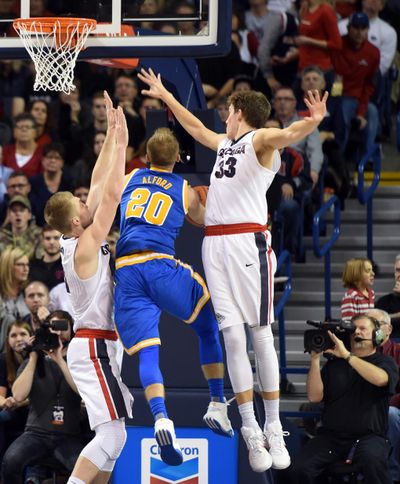Pair of aces leaves Gonzaga Bulldogs feeling flush

Kyle Wiltjer lobbied to do post-practice interviews Tuesday with Gonzaga frontcourt sidekick Domantas Sabonis as a package deal. Wiltjer even buried a 30-foot shot in hopes of changing the minds of television interviewers.
Wiltjer and Sabonis eventually accommodated the media with separate interviews. Much like their performance on the court, they excel individually and collectively.
Wiltjer is on track to become the first Zag to average at least 20 points since Adam Morrison’s 28.1 per game resulted in co-national player of the year honors in 2006. Sabonis isn’t far behind at 18.9 points.
“He’s tough, he’s intense,” Wiltjer said of Sabonis. “I’ve always been the quieter guy. He’s the emotional guy out there, he gets me fired up.”
The pair average 40.4 points per game. That’s the highest duo since Morrison/J.P. Batista combined for 47.4 in 2006. Other high-scoring tandems since GU’s first NCAA tournament appearance in 1995: Casey Calvary/Dan Dickau 37.9 in 2001, Bakari Hendrix/Matt Santangelo 36.1 in 1998 and Morrison/Ronny Turiaf 34.9 in 2005.
Dickau, at 21 ppg in 2002, is the only other Zag in that two-decade span to average at least 20 points. Hendrix finished at 19.9 in 1998.
Sabonis seems to show another addition to his offensive arsenal every game. The left-hander drained a right-handed jump hook in Saturday’s win over Portland. He’s polished his moves and expanded his shooting range. He had four assists against the Pilots and he’s becoming a better passer out of double-teams.
“Being able to play without fouling has been big,” coach Mark Few said. “He’s sustaining his effort, he’s playing good minutes. Earlier in the year, he’d get tired and it would lead to bad decisions or dumb fouls. He’s doing a much better job of managing all that.”
The roles of Sabonis and Wiltjer have changed without Przemek Karnowski, who had season-ending back surgery. Through six games, Sabonis was averaging 13.5 points. Karnowski played in the first five games.
“It’s a completely different role from last year (when) I was coming off the bench,” Sabonis said. “This year I have to take more responsibility. With Shem’s injury it’s just us three (bigs), me, Wiltjer and Ryan Edwards, so I just have to step up.”
Wiltjer and/or Sabonis have led or shared scoring honors in every game except Santa Clara (Josh Perkins’ 26). Silas Melson’s 15 points shared game-high honors with Sabonis against Mt. St. Mary’s.
Wiltjer (foot) has been able to practice more this week. He’s only had one single-digit game, nine points against Pepperdine. He has three 30-point games, including the last two, and seven others with at least 20. He’s made 52 percent of his 3-point attempts in conference games.
The two are averaging 45.8 points in WCC play.
“We’re just in desperate need of a (nick)name,” Wiltjer cracked. “I haven’t thought of any. They’re all inappropriate so I can’t share them.”
Lights, camera, Zags
HBO will air a five-episode series “Gonzaga: The March to Madness” on the Zags’ 2016 season each Tuesday from Feb. 16 to March 15, two days after Selection Sunday.
The series will be narrated by actor Liev Schreiber.
“We have a great group of guys so there’s not really anything they had to filter out. Just be yourself and let the cameras show who we really are,” point guard Josh Perkins said. “They come to the house, watch workouts, individual interviews, our lives pretty much.”
HBO’s Hard Knocks, featuring behind-the-scenes access to an NFL team, debuted in 2001 and has won 12 sports Emmy Awards. This is HBO’s first reality series with a collegiate team. Notre Dame’s 2015 football team was the subject of a Showtime documentary.
“Hard Knocks has been an incredibly well done series,” Few said. “Certainly with just branding and recognition and it’s another way they get to see the insides of the program and how we operate and who we are as people. I don’t think it can do anything but help with recruiting.”
Few was skeptical initially.
“That’s not my favorite thing to give up my private aspects, I don’t have that many things that are private anymore,” he said. “But they’ve been great people and they totally get it. Some days I’m good with it, some days I’m fairly guarded.”